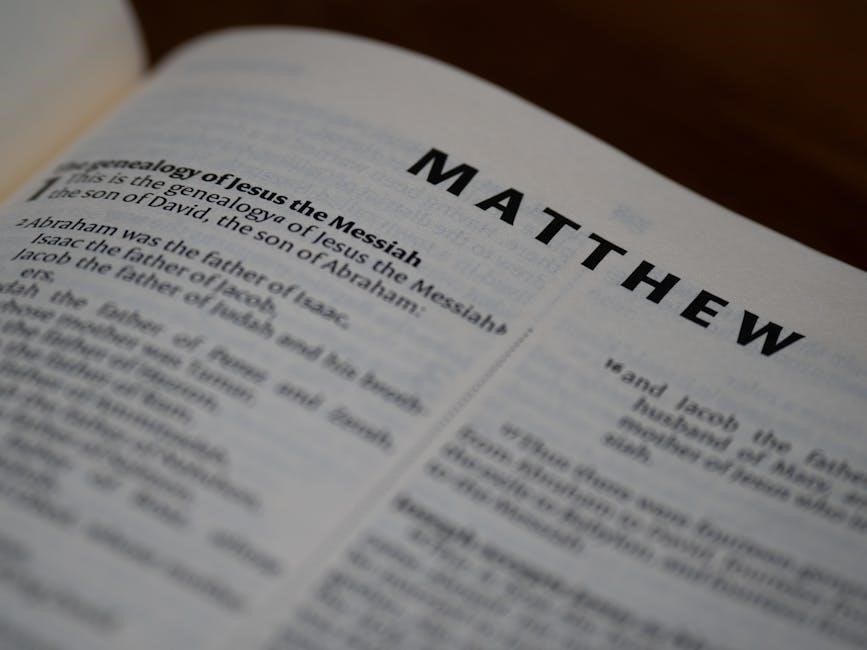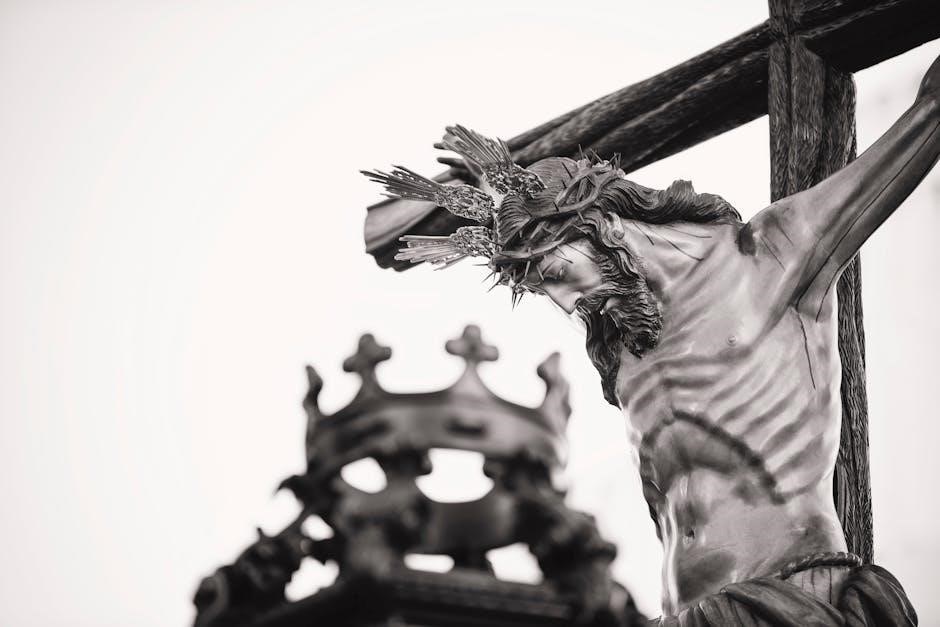The genealogy of Jesus, recorded in Matthew and Luke, establishes His Messiahship and divine heritage. These accounts link Jesus to Abraham, David, and Adam, showcasing His historical and theological significance. Matthew traces Joseph’s lineage, emphasizing royal lineage, while Luke highlights Mary’s, connecting Jesus to humanity. This dual record underscores Jesus’ role as both King and Savior, providing a rich tapestry of His ancestry for biblical study and reflection.
Overview of the Importance of Genealogy in Biblical Context
In the biblical context, genealogy serves as a vital tool for establishing identity, legitimacy, and heritage. It connects individuals to their ancestors, ensuring continuity of covenant promises and cultural traditions. For Jesus, genealogies in Matthew and Luke validate His Messiahship, linking Him to Abraham and David, key figures in Israel’s history. This lineage underscores His rightful claim to the throne of David and fulfills Old Testament prophecies. By tracing Jesus’ ancestry, the Gospels affirm His divine and human nature, bridging the gap between God’s promises to Israel and His universal mission. Genealogy thus becomes a theological foundation, rooting Jesus in history and prophecy.
The Purpose of Tracing Jesus’ Lineage
Tracing Jesus’ lineage serves to authenticate His identity as the Messiah and fulfill biblical prophecies. Matthew’s genealogy links Jesus to Abraham and David, emphasizing His Jewish heritage and royal lineage. Luke’s broader genealogy, extending to Adam, highlights Jesus’ universal relevance to all humanity. By documenting His ancestry, the Gospels confirm Jesus’ legal and biological claims to the throne of David and His role as the Son of God. This lineage also underscores the continuity of God’s covenant promises, from Abraham through David to Jesus, the ultimate fulfillment of Old Testament expectations and the Savior of both Jews and Gentiles.
The Role of Matthew and Luke in Recording Jesus’ Genealogy
Matthew and Luke each recorded Jesus’ genealogy to serve distinct theological purposes. Matthew, writing for a Jewish audience, traced Jesus’ lineage through Joseph, emphasizing His royal descent from Abraham and David, fulfilling Old Testament prophecies of the Messiah. Luke, targeting a broader audience, traced Jesus’ lineage through Mary, linking Him to Adam and highlighting His universal relevance to all humanity. Together, their genealogies complement each other, providing both legal and biological connections to Israel’s history. This dual record reinforces Jesus’ identity as the Messiah and Son of God, bridging Jewish expectations with a universal salvation message;

Matthew’s Genealogy of Jesus
Matthew’s genealogy traces Jesus’ lineage through Joseph, emphasizing His royal descent from Abraham and David. It establishes Jesus as the Messiah, fulfilling biblical prophecies and expectations.
Structure and Content of Matthew 1:1-17
Matthew 1:1-17 presents Jesus’ genealogy in a structured format, dividing it into three sections: from Abraham to David, David to the Babylonian exile, and the exile to Joseph. This arrangement emphasizes Jesus’ royal and messianic lineage, highlighting key figures like Abraham, David, and Solomon. The genealogy includes 42 generations, symbolizing completeness and divine order. Notably, it mentions four women—Tamar, Rahab, Ruth, and Bathsheba—underscoring God’s grace in unexpected lives. The list concludes with Joseph, Jesus’ legal father, linking Him to King David and fulfilling Old Testament prophecies. This structure establishes Jesus as the Messiah, born to redeem humanity.
The Lineage from Abraham to David
Matthew’s genealogy begins with Abraham, the father of the faithful, and traces Jesus’ lineage through Isaac, Jacob, Judah, Perez, Hezron, Ram, Amminadab, Nahshon, Salmon, Boaz, Obed, and Jesse, culminating in David. This section establishes Jesus’ roots in Israel’s patriarchal history, emphasizing His connection to the covenant promises made to Abraham. The inclusion of figures like Rahab and Ruth highlights God’s grace in incorporating Gentiles into His plan. This lineage sets the stage for Jesus as the fulfillment of God’s promises to Abraham and the rightful heir to David’s throne, underscoring His messianic identity and divine purpose.
The Royal Line from Solomon to Joseph
Matthew’s genealogy continues from Solomon, tracing the royal lineage through Rehoboam, Abijah, Asa, Jehoshaphat, Joram, Uzziah, Jotham, Ahaz, Hezekiah, Manasseh, Amos, Josiah, and Jeconiah, leading to Joseph. This section highlights the royal bloodline, emphasizing Jesus’ connection to Israel’s kings, particularly David. The inclusion of figures like Solomon underscores the transfer of the kingdom’s authority, while the mention of Jeconiah reflects the curse on the royal line. Despite this, Joseph’s legal paternity ensures Jesus’ rightful claim to David’s throne, reinforcing His messianic identity and divine authority as the Son of David, the promised Messiah and King of Israel.
The Inclusion of Key Figures: Abraham, David, and Joseph
Abraham, David, and Joseph are pivotal figures in Matthew’s genealogy of Jesus. Abraham, as the father of the faithful, represents the covenant promises, while David, the king, establishes Jesus’ royal lineage. Joseph, though not Jesus’ biological father, provides the legal paternity, linking Jesus to the royal line of David. These figures emphasize Jesus’ identity as the Messiah and Son of God, fulfilling Old Testament prophecies. Their inclusion underscores the theological significance of Jesus’ heritage, connecting Him to Israel’s history and divine promises, while also highlighting His universal mission as the Savior of humanity. This lineage validates Jesus’ authority and mission.
Theological Significance of Matthew’s Genealogy
Matthew’s genealogy of Jesus carries profound theological significance, establishing Him as the fulfillment of Old Testament promises. By tracing Jesus’ lineage through Abraham and David, Matthew affirms His role as the Messiah, destined to inherit the covenant promises. The inclusion of figures like Ruth and Rahab highlights God’s grace and inclusion of Gentiles, foreshadowing Jesus’ universal mission; The structured format, with three sets of fourteen generations, symbolizes divine order and completion. This genealogy serves as a theological bridge, connecting Jesus to Israel’s history while introducing Him as the Savior for all nations, thus forming the foundation of Christian theology and identity.

Luke’s Genealogy of Jesus
Luke’s genealogy traces Jesus’ lineage back to Adam, emphasizing His universal humanity. Recorded in Luke 3:23-38, it highlights Jesus as the Son of God for all people.

Structure and Content of Luke 3:23-38
Luke’s genealogy in Luke 3:23-38 traces Jesus’ lineage backward from Joseph to Adam, emphasizing His universal humanity. It begins with Jesus at age 30, transitioning to Joseph, then reversing chronologically. This structure highlights Jesus as the “Son of God” and connects Him to all humanity, unlike Matthew’s focus on Jewish royalty. The genealogy spans about 75 generations, including key figures like Adam, Noah, and Abraham, showcasing Jesus’ role as the savior for all people. Luke’s account is unique, as it places Jesus within the broader human family, underscoring His mission to redeem humanity universally. This reversal emphasizes theological purpose over historical lineage.
The Lineage from Jesus Back to Adam
Luke’s genealogy uniquely traces Jesus’ lineage backward from Joseph to Adam, creating a universal scope. This reverse structure emphasizes Jesus as the “Son of God” and connects Him to all humanity. The lineage includes key figures like Noah, Abraham, and Adam, highlighting Jesus’ role as the savior for all people. This approach differs from Matthew’s forward structure, which focuses on Jewish royalty. Luke’s account spans over 70 generations, showcasing Jesus’ divine mission to redeem humanity. The inclusion of Adam underscores Jesus’ connection to the entire human race, reinforcing His universal appeal and purpose beyond Jewish heritage.
The Universal Scope of Luke’s Genealogy
Luke’s genealogy extends from Jesus to Adam, symbolizing His universal mission. Unlike Matthew’s focus on Jewish royalty, Luke connects Jesus to humanity’s origin, emphasizing His role as a savior for all. The lineage spans over 70 generations, tracing through Noah and Adam, highlighting Jesus’ divine purpose beyond Jewish heritage. This universal scope underscores His connection to all people, reinforcing His mission to redeem humanity. By tracing back to Adam, Luke portrays Jesus as the ultimate descendant, bridging the gap between the divine and humanity, and fulfilling God’s promise to all nations through His lineage. This approach broadens the theological significance of His ancestry.
The Inclusion of Key Figures: Adam, Noah, and Mary
Luke’s genealogy uniquely includes Adam, Noah, and Mary, highlighting Jesus’ universal significance. Adam, as humanity’s first father, connects Jesus to all people, emphasizing His role as the ultimate descendant. Noah, representing righteousness, underscores Jesus’ mission to redeem humanity. Mary’s inclusion, tracing her lineage, shows Jesus’ royal heritage through her, fulfilling Jewish legal requirements. This broad scope contrasts Matthew’s focus on Joseph’s lineage, emphasizing Jesus’ divine purpose for all nations. These figures collectively illustrate Jesus’ connection to both humanity’s origins and its redemption, making His genealogy a testament to His universal mission and divine heritage.
Theological Significance of Luke’s Genealogy
Luke’s genealogy, tracing Jesus’ lineage to Adam, emphasizes His universal mission and humanity’s unity. By linking Jesus to Adam, Luke underscores His role as the second Adam, redeeming humanity from sin. This contrasts with Matthew’s focus on Jesus as the Messiah for Israel. Luke’s account highlights Jesus’ connection to all people, transcending Jewish heritage. It also connects Jesus to key figures like Noah, symbolizing divine covenant and renewal. Mary’s inclusion ensures Jesus’ royal lineage, fulfilling legal requirements. Thus, Luke’s genealogy proclaims Jesus as the Savior for all humanity, bridging the gap between Israel’s promises and the world’s redemption through His divine mission.

Comparative Analysis of Matthew and Luke’s Genealogies
Matthew and Luke’s genealogies differ in structure and focus, reflecting distinct theological purposes. Matthew traces Jesus’ royal lineage through Joseph, while Luke emphasizes His universal humanity through Mary.
Differences in Genealogical Structure
Matthew and Luke present distinct genealogical structures, reflecting their theological aims. Matthew’s genealogy (Matthew 1:1-17) begins with Abraham and moves forward to Jesus, emphasizing His royal lineage through Joseph. It highlights key figures like David and Solomon, focusing on Jesus as the Messiah and King. Luke’s genealogy (Luke 3:23-38) traces backward from Jesus to Adam, underscoring His universal connection to humanity. While Matthew focuses on the legal lineage through Joseph, Luke emphasizes Mary’s lineage, linking Jesus to the broader human family; These structural differences highlight their unique purposes: Matthew’s royal focus and Luke’s universal appeal.
Variations in Ancestral Lines
The genealogies of Jesus in Matthew and Luke exhibit notable variations in their ancestral lines. Matthew’s account follows the lineage through Joseph, tracing a path from Abraham to Jesus, emphasizing the royal and legal lineage. Luke, however, presents a different lineage, tracing from Jesus back to Adam, likely through Mary’s line. This divergence is evident in the names listed after David; Matthew includes Solomon and the kings of Judah, while Luke lists Nathan and other figures. These variations highlight different theological purposes: Matthew establishes Jesus as the Messiah-King, while Luke portrays Him as the universal Savior, connecting Him to all humanity through Adam.
The Role of Joseph and Mary in the Genealogies
Joseph and Mary play distinct roles in the genealogies of Jesus. Matthew’s genealogy traces Jesus’ lineage through Joseph, emphasizing His legal and royal heritage as the son of David. Luke, however, focuses on Mary’s lineage, connecting Jesus to the broader humanity through Adam. Mary’s genealogy highlights her royal descent, ensuring Jesus’ eligibility as Messiah through her lineage. Joseph’s role establishes Jesus’ legal claim to David’s throne, while Mary’s biological connection confirms His divine and human nature. Together, their roles in the genealogies validate Jesus’ identity as both the Son of God and the Son of David, fulfilling biblical prophecies.
Reconciling the Differences Between the Two Accounts
The differences in Matthew and Luke’s genealogies are often explained by their distinct purposes. Matthew’s genealogy through Joseph emphasizes Jesus’ legal and royal lineage, while Luke’s through Mary highlights His divine and universal connection to humanity. Both accounts are accurate but serve different theological aims. Matthew traces Jesus’ lineage from Abraham to Joseph, focusing on the messianic promise, while Luke connects Jesus to Adam, symbolizing His role as the Savior of all humanity. This duality underscores Jesus’ identity as both the Son of David and the Son of God, reconciling legal and biological heritage to fulfill biblical prophecy and universal salvation.

Key Figures in Jesus’ Genealogy
Abraham, David, Joseph, and Mary are central figures in Jesus’ lineage. Abraham as the father of faith, David as the royal ancestor, Joseph as the legal father, and Mary as the mother of Jesus, each contributing uniquely to His divine and human heritage.
Abraham: The Father of the Faithful
Abraham, known as the father of the faithful, holds a pivotal role in Jesus’ genealogy. As the first patriarch, he received God’s covenant promises, including the assurance of numerous descendants. Matthew’s genealogy begins with Abraham, highlighting his significance as the root of Jesus’ lineage. Abraham’s faith and obedience exemplified the trajectory of God’s plan, culminating in Jesus as the ultimate fulfillment of these promises. His inclusion in the genealogy underscores the theological connection between Jesus and the patriarchal roots of Israel, reinforcing Jesus’ role as the Messiah and heir of Abraham’s blessings, destined to bless all nations.
David: The King and Ancestor of Jesus
David, the second king of Israel, is a central figure in Jesus’ genealogy, as both Matthew and Luke trace Jesus’ lineage through him. In Matthew, the genealogy emphasizes Jesus’ royal lineage, descending from David through Solomon, while Luke traces it through Nathan, another son of David. David’s reign and covenant with God established the messianic hope, fulfilled in Jesus as the ultimate King. His inclusion in the genealogy underscores Jesus’ legitimacy as the Messiah and heir to David’s throne, reinforcing the theological theme of Jesus as the Son of David and the fulfillment of Old Testament promises. This lineage is pivotal to Jesus’ identity and mission.

Joseph: The Legal Father of Jesus
Joseph, as the legal father of Jesus, plays a crucial role in the genealogy recorded in Matthew’s Gospel. His lineage traces back to King David and Abraham, establishing Jesus’ royal heritage. Matthew’s genealogy highlights Joseph’s descent through Solomon, emphasizing Jesus’ legal right to the throne of David. While Luke’s genealogy focuses on Mary’s lineage, Joseph’s role remains significant as the legal father, ensuring Jesus’ inheritance of the royal line. This legal lineage underscores Jesus’ identity as the Messiah and King, fulfilling Old Testament prophecies. Joseph’s genealogy serves as a vital link in confirming Jesus’ divine and royal heritage, essential for understanding His mission and authority.
Mary: The Mother of Jesus and Her Lineage
Mary, the mother of Jesus, holds a unique place in His genealogy, as her lineage is traced in Luke’s Gospel. Unlike Matthew, who focuses on Joseph’s royal line, Luke emphasizes Mary’s ancestry, linking Jesus to David through Nathan, not Solomon. This distinction underscores Jesus’ rightful claim to the throne through both His legal and biological heritage. Mary’s lineage includes figures like Levi and Matthat, highlighting her priestly and royal connections. Her ancestry, rooted in the house of David, ensures Jesus’ qualifications as the Messiah. This maternal lineage, recorded by Luke, complements Joseph’s legal lineage, providing a comprehensive view of Jesus’ divine and human heritage.

Theological Implications of Jesus’ Genealogy
Jesuss genealogy confirms His Messiahship, fulfilling Old Testament promises through His lineage from David and Abraham. Lukes universal scope traces His ancestry to Adam, emphasizing His role as Savior for all humanity, while Matthews royal lineage establishes His authority as King. This dual heritage underscores Jesuss divine and human nature, reinforcing the theological foundation of His mission and identity as the Son of God and Son of Man.
Jesus as the Messiah and Son of David
MATTHEW’S GENEALOGY establishes Jesus as the Messiah by tracing His lineage through King David, fulfilling Old Testament prophecies. As the “Son of David,” Jesus inherits the royal right to Israel’s throne, solidifying His authority and mission. This lineage validates His identity as the promised Messiah, emphasizing His divine and legal claim to kingship. The inclusion of key figures like Abraham and David underscores His connection to Israel’s history and covenant promises. Through this, Matthew demonstrates that Jesus is the rightful heir, fulfilling God’s plan to redeem humanity; This theological foundation reinforces Jesus’ role as both King and Savior, central to Christian belief.
Jesus as the Son of Abraham and Heir of the Promises
Jesus’ lineage through Abraham, as recorded in Matthew’s genealogy, establishes Him as the rightful heir to the divine promises. Abraham, the father of the faithful, received God’s covenant of blessings, land, and a multitude of descendants. By tracing Jesus’ ancestry back to Abraham, Matthew emphasizes His connection to Israel’s patriarchal heritage. This lineage underscores Jesus’ role as the fulfillment of God’s promises to Abraham, extending beyond Israel to all nations. As the Son of Abraham, Jesus inherits the spiritual and universal dimensions of these promises, making Him the source of blessings for humanity. His heritage validates His mission to redeem and restore all people to God.
The Universal Appeal of Jesus’ Lineage in Luke
Luke’s genealogy uniquely traces Jesus’ lineage back to Adam, emphasizing His connection to all humanity. Unlike Matthew, who focuses on Abraham and David, Luke highlights Jesus as the Son of God for all people. By extending the lineage to Adam, Luke underscores the universal scope of Jesus’ mission, showing Him as the descendant of the first man and the Savior of the entire human race. This approach emphasizes God’s plan to redeem all nations through Jesus, making His heritage inclusive and universally relevant. Luke’s genealogy thus bridges cultural and historical divides, presenting Jesus as the ultimate unifier of humanity. This universal appeal reflects God’s desire for salvation to reach every corner of the world.
The Historical and Spiritual Significance of Jesus’ Heritage
Jesus’ heritage, documented in Matthew and Luke, holds profound historical and spiritual importance. Historically, it validates His Messianic credentials, linking Him to Israel’s patriarchs and kings, fulfilling Old Testament prophecies. Spiritually, it reveals God’s redemptive plan, tracing from Abraham to Jesus, the ultimate heir of divine promises. His lineage bridges humanity’s past to its redemptive future, embodying the continuity of God’s covenantal love. This duality underscores Jesus as both a historical figure and the spiritual Savior, whose genealogy serves as a testament to His divine mission and humanity’s salvation. His heritage thus anchors faith in historical reality and spiritual truth.

Historical and Cultural Context
The genealogy of Jesus reflects 1st-century Jewish practices, where lineage verified identity and authority. It connected Him to Israel’s history, fulfilling Messianic expectations rooted in tradition.
Jewish Genealogical Practices in the First Century
In the first century, Jewish genealogical practices were meticulous, with records often maintained by priests or scribes. These records served to establish identity, authority, and inheritance rights, particularly for tribal and priestly lineages. Genealogies were crucial for maintaining purity of lineage, especially for those in royal or priestly roles. Families kept detailed accounts, often stored in public archives or family records. This practice ensured continuity and legitimacy, particularly for messianic claims. The emphasis on lineage was rooted in Old Testament traditions, where ancestry determined societal roles and spiritual heritage. This context underscores the significance of Jesus’ genealogy in verifying His messianic credentials and connection to Israel’s history.
The Role of Genealogy in Establishing Identity and Authority
Genealogy played a pivotal role in establishing identity and authority in ancient Jewish society. By tracing lineage, individuals could verify their tribal affiliation, inheritance rights, and eligibility for religious or leadership roles. For Jesus, His genealogy was crucial in confirming His messianic identity. Matthew’s account emphasizes Jesus’ royal lineage through Joseph, linking Him to King David and Abraham, while Luke’s broader genealogy connects Jesus to Adam, symbolizing His universal relevance. These records were essential for validating Jesus’ authority as the Messiah, ensuring His credentials aligned with scriptural prophecies and expectations. Genealogy thus served as a foundational proof of His divine and historical legitimacy.
Cultural Significance of Royal and Priestly Lineages
In ancient Jewish culture, royal and priestly lineages held immense significance, validating authority and divine appointment. Jesus’ genealogy, as recorded in Matthew and Luke, strategically intertwines both. The royal lineage, tracing through King David, affirmed Jesus’right to the throne, fulfilling messianic expectations. Meanwhile, the priestly lineage, often subtly implied through figures like Mary and her Levitical heritage, established Jesus’ spiritual authority. This duality—royal and priestly—mirrored the ideal Jewish leader, uniting political and religious roles. By embedding these lineages, the Gospels culturally situated Jesus as the Messiah, bridging earthly kingship and heavenly priesthood, thereby solidifying His identity and divine mandate for redemption.

Modern Relevance and Resources
Today, the genealogy of Jesus remains a vital tool for biblical study, with PDF resources and online platforms offering detailed charts and theological insights, enhancing contemporary understanding.
Availability of Genealogy of Jesus in PDF Format
The genealogy of Jesus is widely available in PDF format, offering detailed charts and theological insights. Websites like Scribd and Adam2Jesus.org provide free downloads, ideal for personal study. These resources trace Jesus’ lineage through Matthew and Luke, highlighting key figures such as Abraham, David, and Mary. The PDFs often include color-coded charts for clarity, making it easier to visualize the ancestral connections. They are valuable tools for understanding the historical and spiritual significance of Jesus’ heritage, aiding Bible study and theological exploration. These documents are freely accessible, enabling deeper engagement with the biblical narrative surrounding Jesus’ ancestry.
Online Resources and Bible Study Tools
Online resources and Bible study tools provide extensive insights into the genealogy of Jesus. Websites like Scribd and Adam2Jesus.org offer free PDF downloads of Jesus’ lineage, tracing His ancestry through Matthew and Luke. These resources include detailed charts, theological commentary, and historical context. Bible Gateway and Logos Bible Software offer interactive tools for exploring the genealogies, while apps like YouVersion provide accessible study materials. These tools enable users to delve into the scriptural accounts, compare genealogical records, and understand the significance of key figures like Abraham, David, and Mary. They are invaluable for personal study, sermon preparation, or group Bible discussions.
The Use of Genealogy in Modern Biblical Studies
In modern biblical studies, the genealogy of Jesus serves as a critical tool for understanding His theological and historical identity. Scholars analyze the lineages in Matthew and Luke to explore themes of Messiahship, kingship, and humanity. The genealogies are used to examine the fulfillment of Old Testament prophecies and the universal appeal of Jesus’ mission. Digital tools and PDF resources have made these genealogies more accessible, enabling researchers to trace connections between key figures like Abraham, David, and Adam. This study deepens the understanding of Jesus’ role as both the Son of David and the Son of God, enriching theological discourse and biblical interpretation.




Be the first to reply